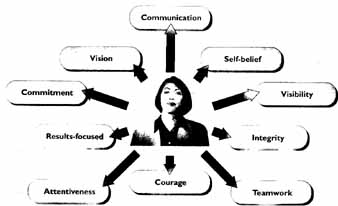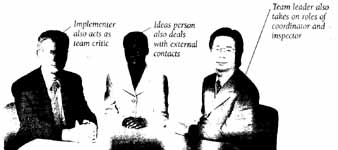In an effective team, all members know their roles thoroughly. While having
their own strengths, skills, and roles, they must also contribute to the “togetherness”
of the team. It is the role of either team leader or senior manager to see
that this happens.
Tip 12: Always choose leaders on merit, regardless of other considerations.
Tip 13: Look for a strong team commitment from a leader.
Tip 14: Always reward merit, but never let errors go unremarked.
ASSESSING LEADERSHIP QUALITIES
All leaders need strong personality traits to assert influence and function.
Some of these attributes are internal, such as vision, but they always have
to be complemented by external qualities, such as high visibility, to produce
the utmost from team members.
A team leader needs to be both facilitator
and inspirer — a business team depends upon its leader to provide it with
the facility to make decisions and the support to grow.

EVALUATING LEADERSHIP QUALITIES: The analysis
of leadership qualities shown below was developed by the UK Insights consultants
and is influenced heavily by the example of famous sports stars The model
indicates the five internal and five external skills that should be present
in a successful leader of teams. Key: Inner strengths; Outer signs. Communication,
Self belief, Visibility, Integrity, Teamwork, Attentiveness, Results-focused,
Vision.
LEADING A TEAM
The performance of any team depends on the quality of its collective thinking. How good are its decisions? This reflects the quality of the decision-making processes. The leader should strive to achieve a positive atmosphere, free from rigidity and envy, in which people compete with ideas — not egos. Teamwork does not function if the leader consistently puts forward ideas before others have had the chance to speak. In the classic Japanese method, the leader listens silently until every team member has expressed an opinion before making the decision for the whole team. A true team leader will facilitate, inspire, and implement rather than control.
Facilitate >> Inspire >> Implement. GIVING INSPIRATION: Team leaders play several roles: they are there to facilitate the making of decisions; to inspire lateral thinking, motivation, and hard work within the team; and to implement decisions made by the team.
UNDERSTANDING LEADERSHIP FUNCTIONS
The main task and function of a leader is to achieve the goals of the team. If you are team leader, ensure your team goals are achieved via these processes:
• Planning roles to be filled and selecting appropriate individuals;
• Leading the team in meetings, starting with a discussion of team objectives and values;
• Ensuring that targets are met and that values — above all, the values of working collectively — are observed by the team;
• Analyzing and correcting failures swiftly and surely — but always remembering to celebrate the successes just as enthusiastically;
• Carrying the responsibility of representing the team loyally to others, both inside and outside the organization.
CULTURAL DIFFERENCES
Styles of leadership vary internationally Americans are accustomed to blunt, assertive leadership, and the Japanese to a consensus, in which unanimous agreement is reached through a laborious process. British managers often conceal firm orders behind apparently woolly statements, while German leaders invite the views of their teams but retain control of all decision- making. True teamwork may bring these styles closer together.
CONSIDERING ROLES
For a team to function most efficiently there are several key roles that should be filled. These include coordinator, ideas person, critic, external contact, implementer, team leader, and inspector.
It is useful to bear these roles in mind when you are considering candidates for team membership, although you should also look for people with the ability to perform the specific tasks on which your team’s operations depend. Never forget that the most important function of a team is to achieve the objective of the task in hand. Remember, too, that a friendly and open personality, and the ability and willingness to work with a group of people, are indispensable characteristics for a team player.
QUESTIONS TO ASK YOURSELF
Do the potential team members have any relevant team experience?
Do the candidates fit readily into any of the key roles needed in the team?
How do candidates see their own potential within the team?
Do the candidates show enthusiasm and understanding for the team’s purpose?
Have any of them ever worked effectively with any other of the potential team members?
Tip 15: Remember that everyone in a team thinks in a different way.
DIVIDING UP ROLES
It does not make sense to fit anyone into a straitjacket. You may find a perfectly equipped external contact or critic; you may not. Try to match roles to personality rather than attempting to shoehorn the personality into the role. It is not necessary for each person to perform only one function. If the team has only a small number of members, doubling or tripling up the roles is fine — as long as all the needs of the team are truly covered and the members feel comfortable with their roles.

SMALLER TEAMS: Double or triple up roles when
a team has only a few members, to ensure that all the key requirements
for the successful completion of the task are catered for.
IDENTIFYING THE KEY ROLES WITHIN TEAMS
TEAM ROLES |
CHARACTERISTICS |
TEAM LEADER: Finds new team members and develops the teamworking spirit |
• Excellent judge of the talents and personalities of individuals within the team. • Adept at finding ways of overcoming weaknesses. • Is a first-class two-way communicator • Good at inspiring and sustaining enthusiasm. |
CRITIC Guardian and analyst of the team’s long-term effectiveness. |
• Never satisfied with less than the best solution. • Expert at analyzing solutions to find the possible weaknesses within them. • Merciless in insisting that faults be corrected. • Constructive in pointing way to possible remedies. |
IMPLEMENTER Ensures the momentum and smooth running of the team’s actions. |
• A born time-tabler who thinks methodically. • Anticipates threatening delays in schedule in time for them to be prevented. • Has a can-do” mentality and loves to fix things. • Able to rally support and overcome defeatism. |
EXTERNAL CONTACT Looks after the team’s external relationships. |
• Diplomatic, and good judge of the needs of others. • Has a reassuring, authoritative presence. • Has an effective grasp of the overall picture of the team’s work. • Discreet when handling confidential information. |
COORDINATOR Pulls together the work of the team as a whole into a cohesive plan. |
• Understands how difficult tasks interrelate. • Has a strong sense of priorities. • Has a mind able to grasp several things at once. • Good at maintaining internal contacts. • Skilled at heading off potential trouble. |
IDEAS PERSON Sustains and encourages the team’s innovative vitality and energy. |
• Enthusiastic and lively, with a zest for new ideas. • Eager for and receptive to the ideas of others. • Sees problems as opportunities for successful innovation, rather than as disasters. • Never at a loss for a hopeful suggestion. |
INSPECTOR Ensures that high standards are sought and maintained. |
• Strict, and sometimes even pedantic in enforcing rigorous standards within the team. • Good judge of the performance of other people. • Unhesitating in bringing problems to the surface. • Able to praise as well as to find fault |
Next: Setting Up a Team
Prev: Matching Team to Task
